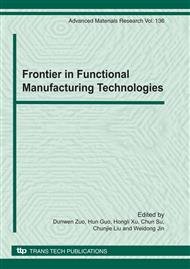p.167
p.172
p.176
p.179
p.184
p.189
p.194
p.202
p.207
Investigation of the Drawing Process of a Square Rod from a Round Bar by Using 3-D Finite Element Analysis
Abstract:
Wire and rod drawing is widely used in metal forming processes to obtain products such as rods and wires. Rods having shaped sections such as square, rectangle and irregular section are necessary to produce connecting pins and components of transformers. Important characteristics of the shaped drawing process are the corner filling and inhomogenious factor of strain that influence the dimensional accuracy and the good quality of the product. In this paper, a three-dimensional rigid-plastic finite element analysis is used to simulate the drawing process of a square rod from a round bar. A finite element method is also used to investigate the corner filling, forming load, stress distribution and inhomogenious factor of effective strain under various process parameter conditions, including the reduction of area, the die semi-angle, and the friction factor
Info:
Periodical:
Pages:
184-188
Citation:
Online since:
October 2010
Authors:
Keywords:
Price:
Сopyright:
© 2010 Trans Tech Publications Ltd. All Rights Reserved
Share:
Citation:


